How to Import Google Sheets Data Into MySQL or MariaDB
Effective data export and import form the backbone of robust database management. Whether you are creating regular backups for data security or facilitating seamless database migration to a new server, the import process plays a pivotal role. Additionally, specific scenarios may arise, such as exporting data from a CRM system for the subsequent import into a MySQL database.
Connecting Google Sheets with a MySQL database: Is it feasible?
Google Sheets is a free web-based spreadsheet program provided by Google. It enables users to create and edit spreadsheets and, more importantly, facilitates collaboration among multiple users on a single document, allowing you to see everybody's contributions in real time. Google Sheets is part of the Google suite of applications, a collection of free productivity apps owned and maintained by Google. While exceptionally accessible and popular, it may not always meet the standards of individual users and businesses. This is when the need to switch to a different solution might arise.
If you have been looking for a way to connect your Google Sheets and a database like MySQL or MariaDB, your search has finally come to an end. Here, we are going to describe the whole process step-by-step using dbForge Studio for MySQL as our playground. This IDE stands out as an invaluable tool, supporting a total of 14 popular formats. The user-friendly graphical interface of the Studio ensures a smooth and effortless experience throughout.
The advantages of integrating Google Sheets into a MySQL database
Migrating from Google Sheets to a MySQL database offers significant advantages, including improved data scalability, enhanced data integrity, and the ability to perform advanced querying with SQL:
- Data scalability: MySQL databases are designed to handle large volumes of data, providing scalability that may be limited in spreadsheet applications like Google Sheets.
- Data integrity: Another advantage of MySQL is its robust data integrity features, which include constraints and foreign key relationships, ensuring the accuracy and consistency of stored information.
- Advanced querying: Complex querying and reporting in MySQL enables users to extract specific information from the database using SQL queries, which may be more challenging in spreadsheet applications.
- Improved performance: MySQL databases are optimized for performance, providing faster data retrieval and processing compared to large Google Sheets files, especially as the dataset grows.
- Enhanced security: Compared to Google Sheets, MySQL offers more advanced security features, including user authentication, access control, and encryption, providing better protection for sensitive data.
- Transaction support: MySQL supports transactions, allowing for the execution of multiple database operations as a single atomic unit, ensuring data consistency and integrity in complex workflows.
- Integration capabilities: If you are working with various applications, tools, and programming languages, MySQL facilitates seamless data exchange and interoperability within a broader ecosystem.
- Centralized data management: Migrating to a MySQL database centralizes data management, making it easier to organize, maintain, and control access to data across teams or departments.
- Scalable architecture: Another strong point for migrating to MySQL is a scalable architecture that allows organizations to expand their data infrastructure as needed, accommodating future growth and evolving business requirements.
- Customization and extensibility: MySQL databases provide a high level of customization and extensibility, allowing users to tailor the database schema and functionality to suit specific business needs.
Import Google Sheets to MySQL using a GUI tool
Without further ado, we are now going to import Google Sheets format to MySQL using dbForge Studio:
1. Decide what table to import the data to:
For a new table
- On the Database menu, point to Tasks and click Import Data. The Data Import wizard opens.
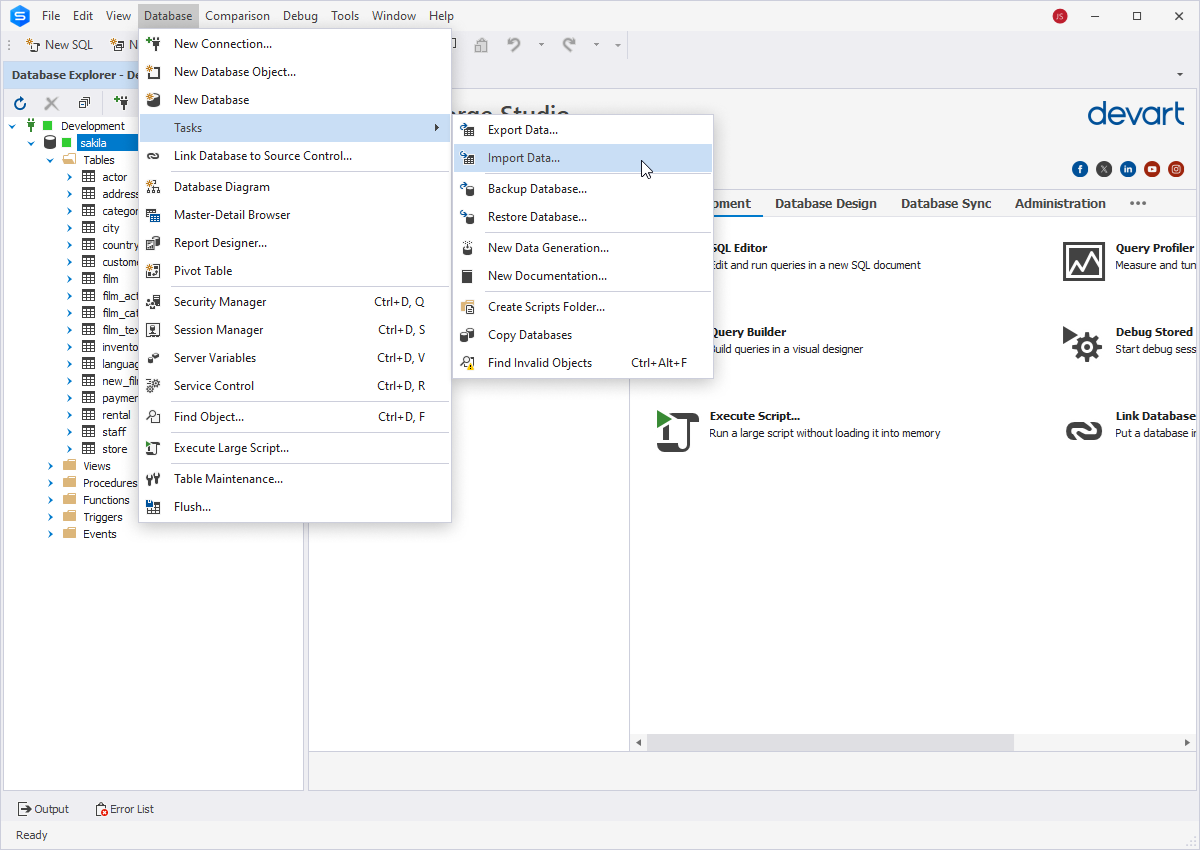
For an existing table
- Right-click a table in Database Explorer, point to Tasks, and select Import Data on the shortcut menu. The Data Import wizard opens with predefined parameters: a MySQL connection, a database, and a table to import the data to.
- Alternatively, on the Database menu, point to Tasks and click Import Data. Then, select a required table.

2. In the Data Import wizard that opens, select the Google Sheets format and specify the ID/URL of the Google Spreadsheet containing the source data.
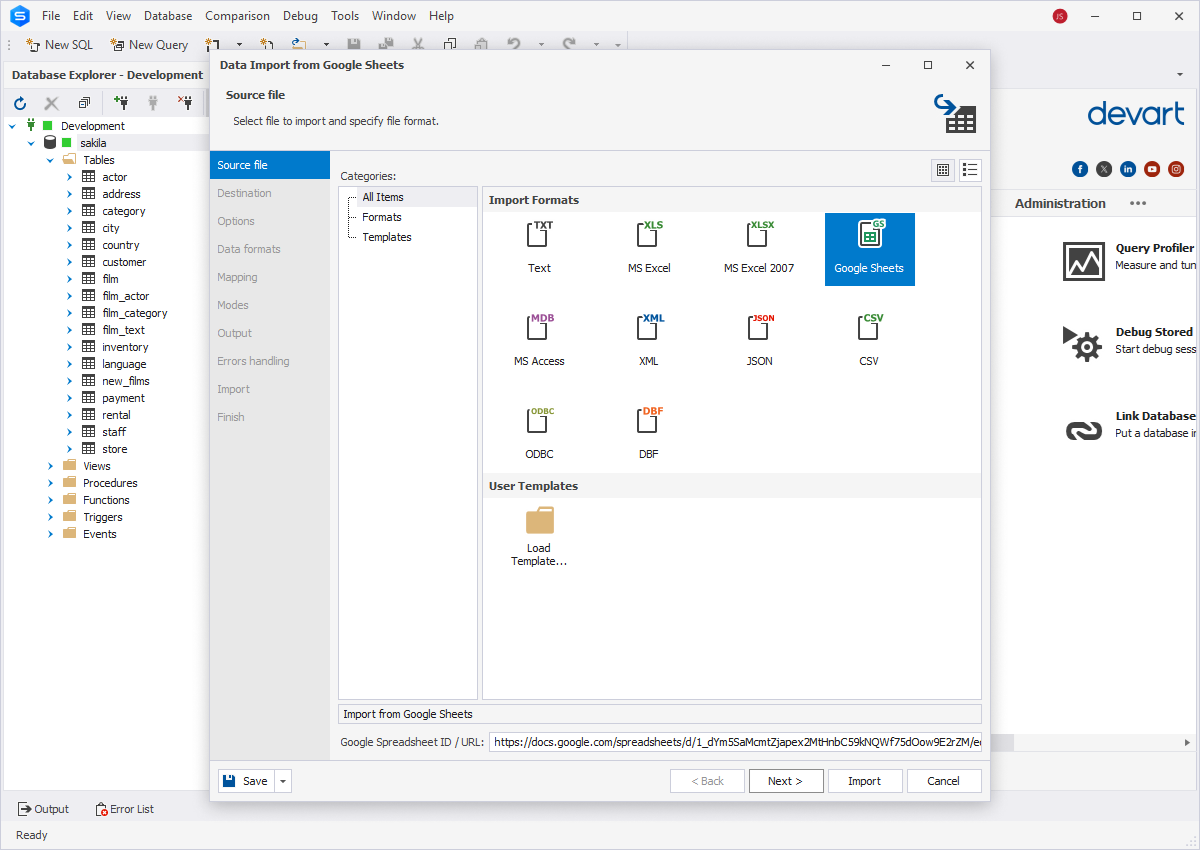
On clicking Next, a browser window will open, prompting you to authenticate with Google. If the authentication was successful in a previous import session, the browser will not display the authentication request again.

3. Specify a MySQL connection, a database, and a table to import the data to. If you select a table in Database Explorer before opening the Data Import wizard, it will open with the predefined connection parameters of the selected table. You can also create or edit MySQL connections during this process.

Click Next.
4. Preview the Source data and specify additional options to customize the import:
- If the source data is located on several sheets, specify which of them to choose for the import.
-
Specify the data range to import. You can see it highlighted in green in the Preview section.
If you want to import the data partially, clear the Detect a range automatically check box and
enter Start Cell and End Cell values, or click
 next to these fields and
double-click a cell in the Preview grid. The specified range will be highlighted in
green, and skipped lines will be highlighted in white.
next to these fields and
double-click a cell in the Preview grid. The specified range will be highlighted in
green, and skipped lines will be highlighted in white.
- Select to import the data either in rows or in columns.
- Specify the header position if required. It will be highlighted in blue in the Preview section. If you do not specify the header position, the imported columns will get default names - column1, column2, etc.

Click Next.
5. Specify data formats for the Source data and click Next.
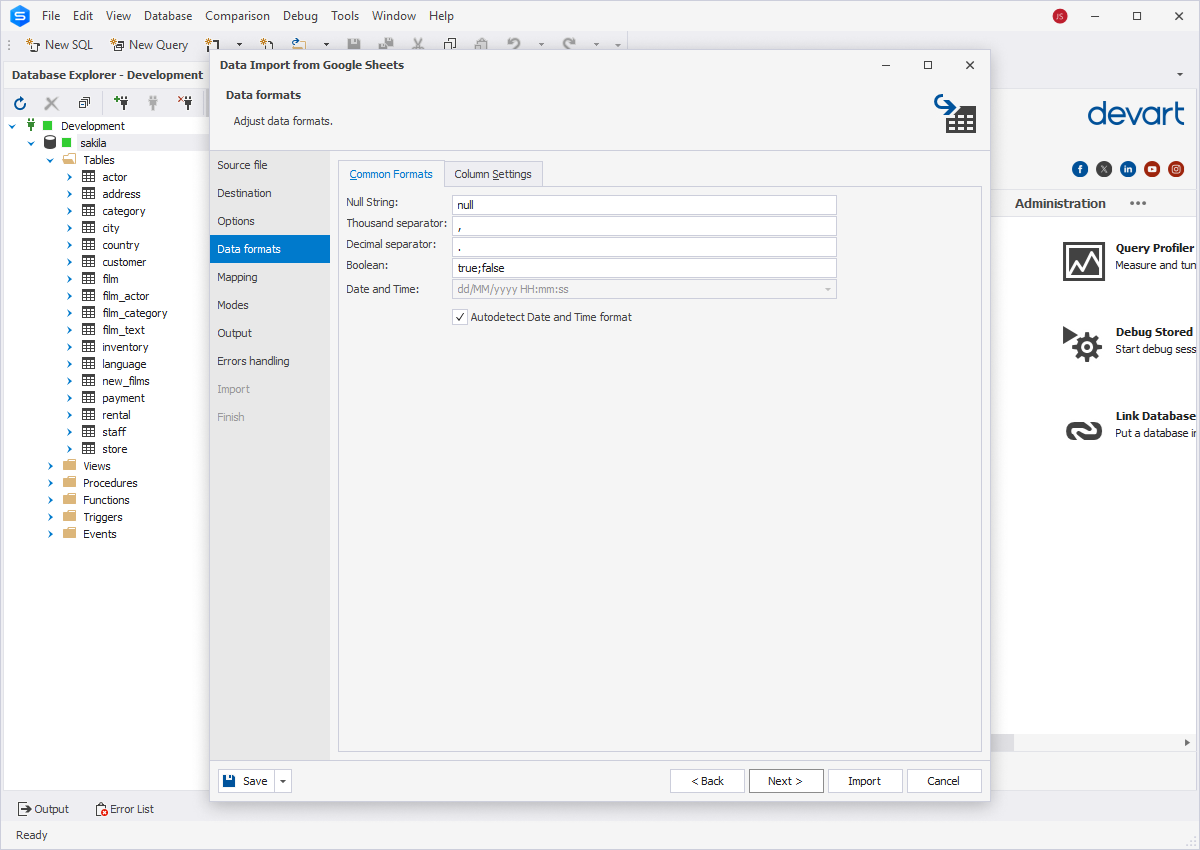
6. Map the Source columns to the Target ones. If you are importing the data into a new table, dbForge Studio will automatically create and map all the columns. If you are importing into an existing table, only columns with the same names will be mapped. The rest should be mapped manually. In case no columns with the same name are found, they are mapped in succession - the 1st column in Source with the 1st column in Target, etc.
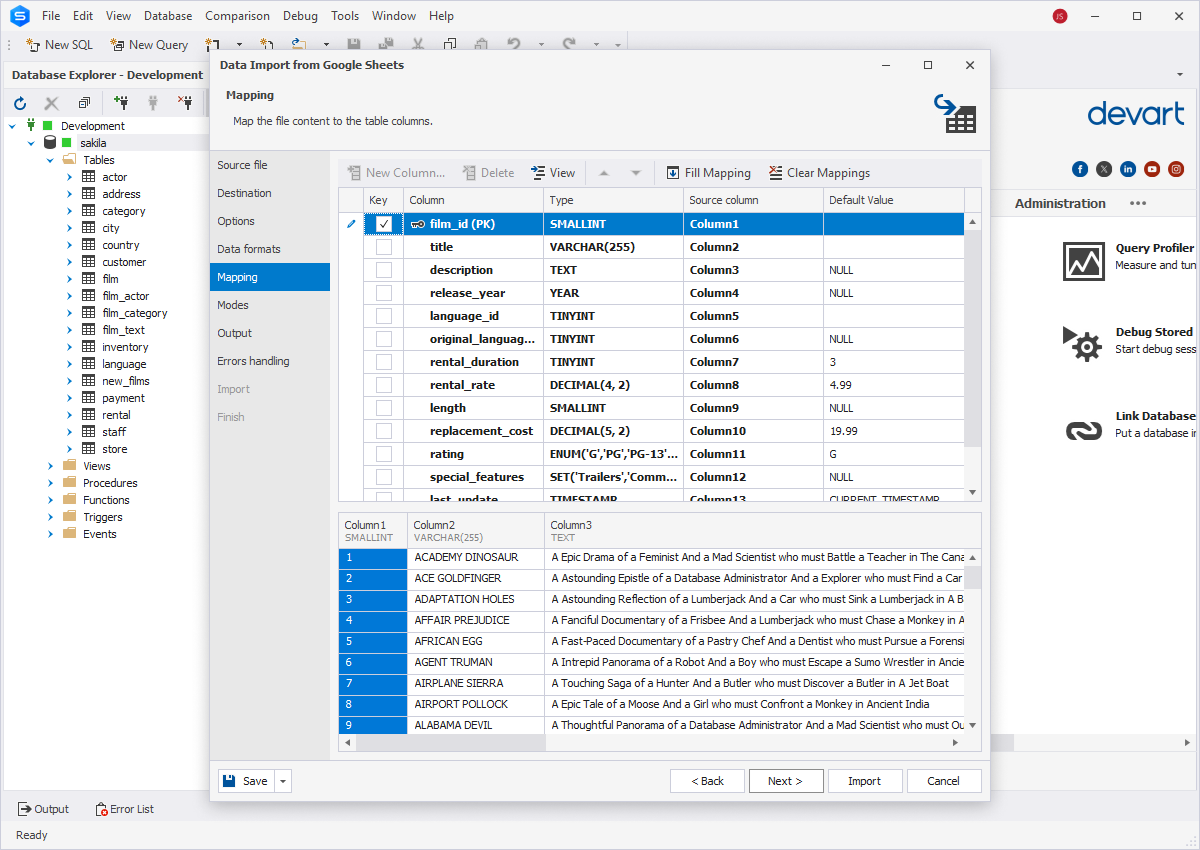
See the Target columns at the top and the Source columns at the bottom of the wizard page. Click the Source column fields and select the required columns from the drop-down list.
In order to cancel the mapping of all the columns, click Clear Mappings on the toolbar. To restore it, click Fill Mapping.
If you are importing to a new table, you can edit the Target column properties by double-clicking them in the top grid. Select the Key check box for a column with a primary key and click Next. Note that you should select at least one column with a primary key. Otherwise, some of the import modes on the Modes wizard page will be disabled.
7. Select the import mode to define how dbForge Studio should import the data. Then, click Next.
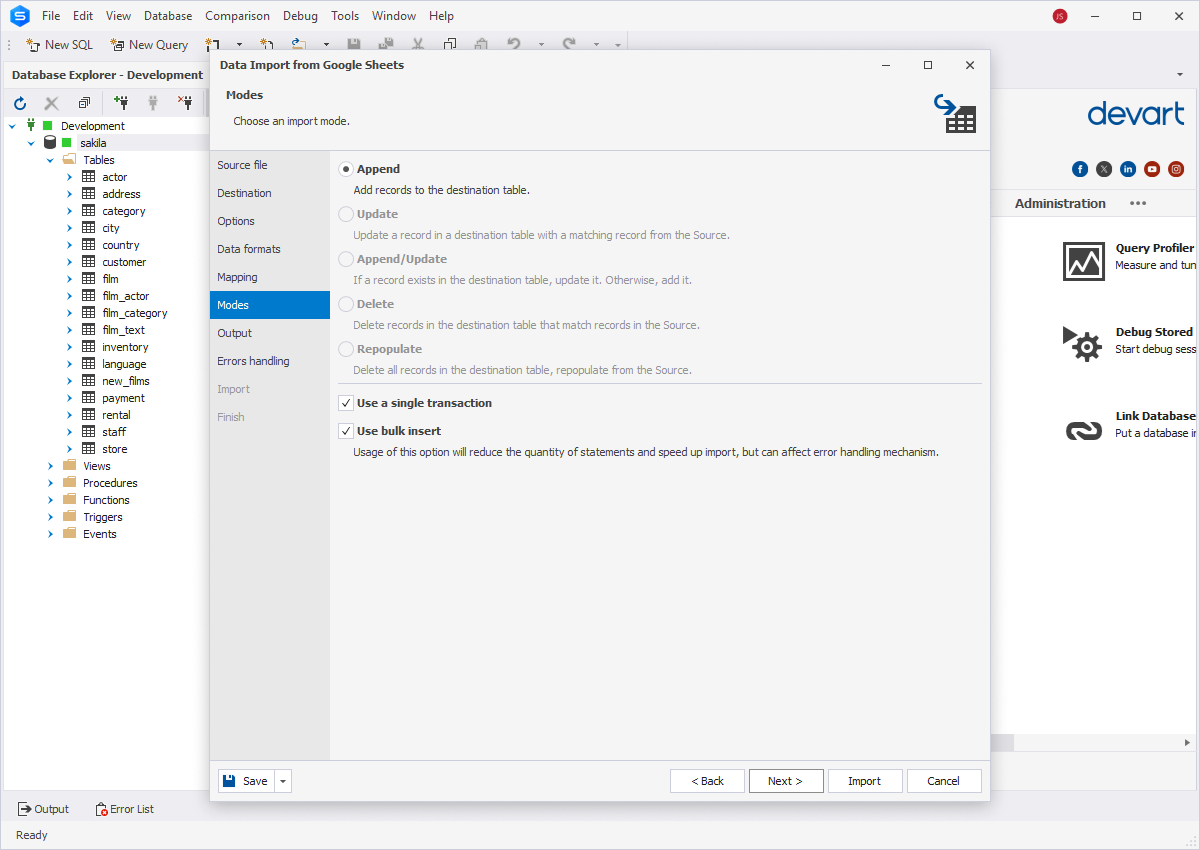
8. Select output options to manage the data import script:
- Open the data import script in the internal editor
- Save the data import script to a file
- Import data directly to the database
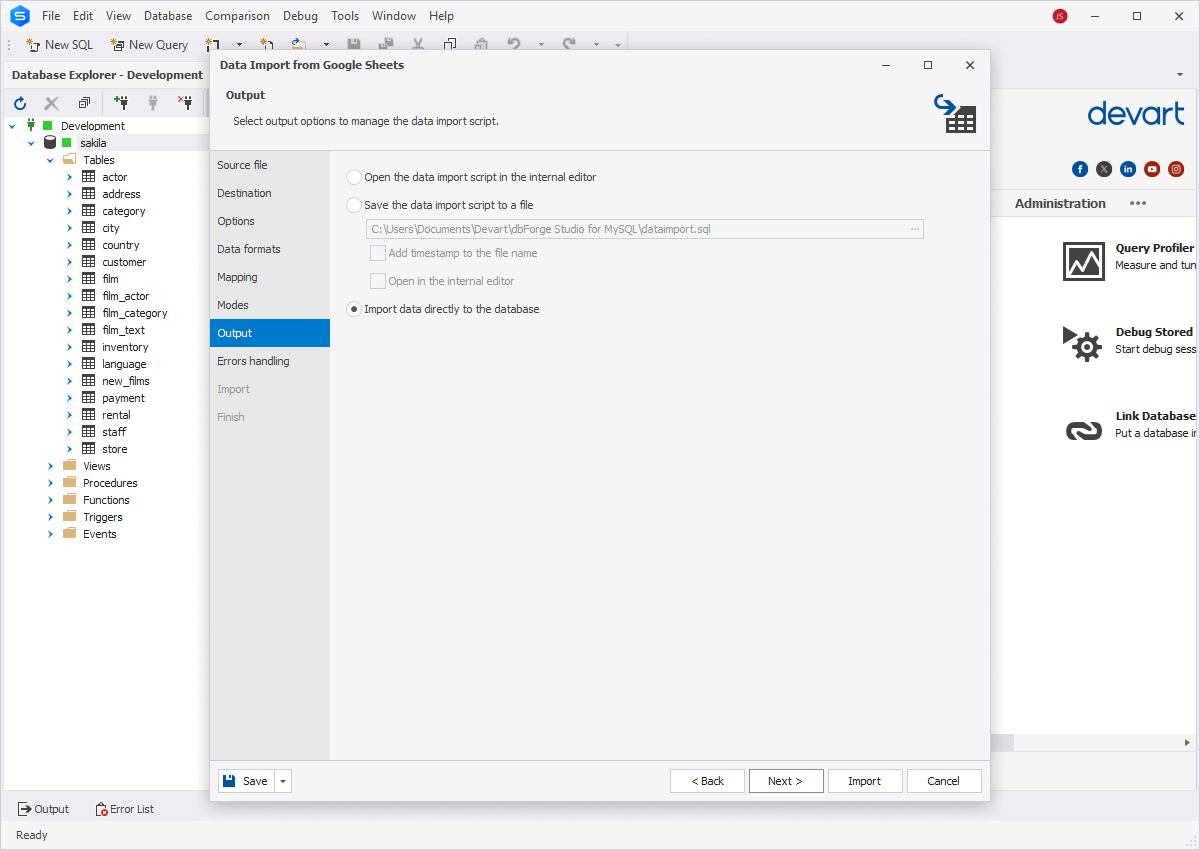
9. On the Errors handling page, select how dbForge Studio should handle errors during import and whether you want to get a log file with details about the import session.
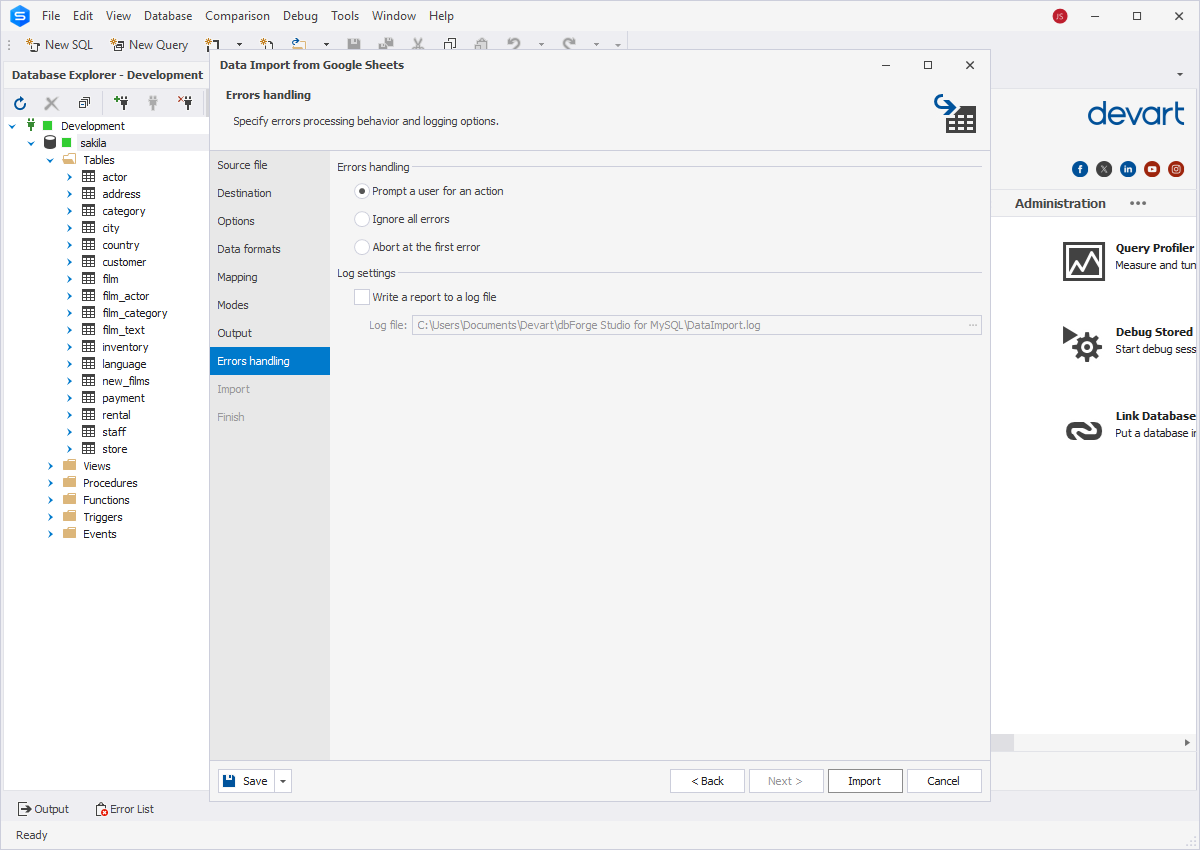
10. Click Import and see the import progress. dbForge Studio will notify you whether the import was completed successfully or failed. Click Show log file to open the log file.
11. Click Finish to finish the import and close the wizard.
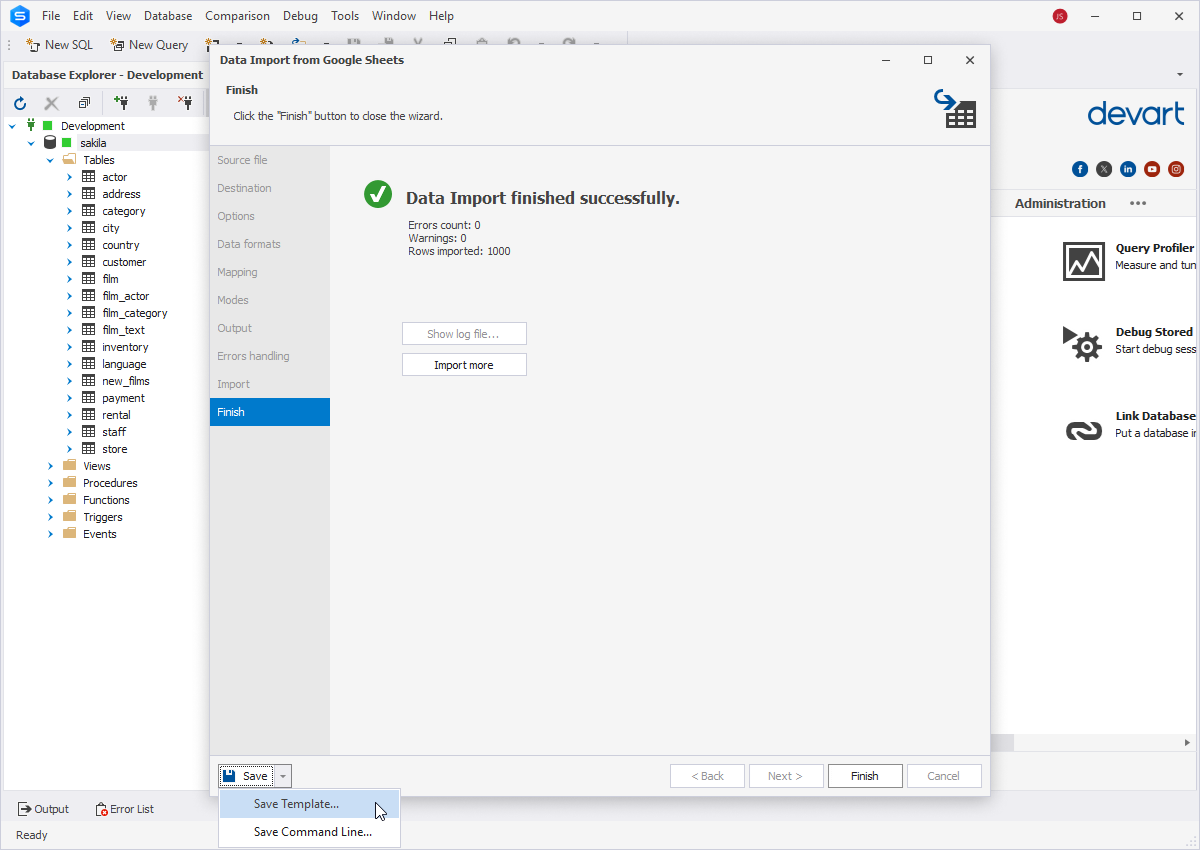
You can save the import settings as a template for future use. Click Save Template on any wizard page to save the selected settings. Next time, you will only have to select a template and specify a location of the Source data - all the settings will be saved.
12. Finally, you can run a SELECT query to make sure your data has been imported to the required table.

Overcoming difficulties in the import processes from Google Sheets to MySQL
Even with careful database management, encountering errors is inevitable during data import. The following table outlines several challenges that may be encountered during the process of importing data from Google Sheets to MySQL, along with corresponding strategies to overcome those:
| Difficulty | Description | Overcoming strategy |
|---|---|---|
| Data format mismatch | Issues may occur when the data format in Google Sheets does not align with the expected format in MySQL, leading to import errors. | Ensure consistent formatting between Google Sheets and MySQL by validating and adjusting data types before import. |
| Formula and reference errors | Formulas and cell references in Google Sheets may not translate accurately into MySQL, causing errors during the import. | Manually review and adjust formulas, or consider exporting values instead of formulas for complex calculations. |
| Permission errors | Inadequate permissions to access or modify Google Sheets or MySQL databases can hinder the process. | Ensure proper permissions for the Google Sheets document and MySQL database, and authenticate with appropriate credentials. |
| Large files | Importing large Google Sheets files into MySQL may pose challenges, therefore impacting performance and causing timeouts. | Break down large files into smaller batches, optimize the import process, or consider using specialized tools for handling large datasets. |
| Encoding problems | Differences in character encoding between Google Sheets and MySQL can result in data corruption or misinterpretation. | Standardize character encoding across both platforms, ensuring compatibility during the import process. |
| Automation and scheduling challenges | Automating the import process or scheduling regular imports may face challenges related to script execution, timing, or reliability. | Implement robust error handling, schedule imports during low-traffic periods, and regularly monitor and adjust automation scripts for optimal performance. |





